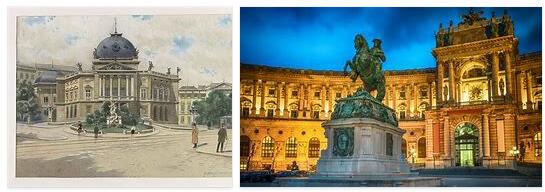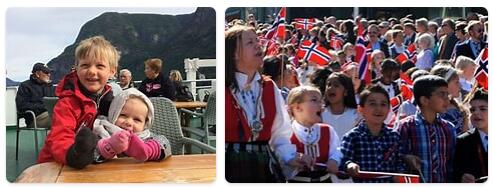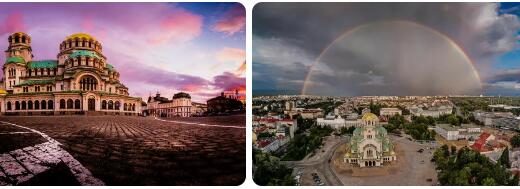History of Vienna, Austria
Following a Celtic settlement, the Romans built the legion camp Vindobona towards the end of the 1st century AD in the course of their fortified northern border (Danube Limes) , which was destroyed in 166 by Marcomanni and Quadi, rebuilt in 170 by Emperor Marcus Aurelius and in 212 as a Municipium was designated. After the collapse of the Limes (395), the secured written tradition was first torn down, but in 881 it is called again as Wenia. The settlement, the continuity of which is archaeologically secured up to the Middle Ages, developed into an important trading center by the 11th century. Around 1135 Vienna (first referred to as Civitas in 1137) came into the possession of the Babenbergs; Heinrich II. Jasomirgott elevated Vienna to the residence of the newly created Duchy of Austria in 1156 at the latest, succeeding Klosterneuburg. The growth of the Danube trade brought Vienna a first boom thanks to its convenient location. In 1221 Vienna was granted city and staple rights (with a monopoly in transit trade), and between 1237 and 1278 the city was elevated to a free imperial city three times. After the Babenbergs died out (1246), Vienna passed to King Ottokar II. Přemysl, and in 1276 to King Rudolf I of Habsburg. Revolts against the new sovereignty were initiated by Duke Albrecht I. Suppressed in 1288, but they resulted in a deteriorated town charter (1296) and the final loss of imperial freedom. In the 14th century, Vienna grew into a populous town as a trading center for goods and developed into an important cultural center. Duke Rudolf IV., The founder, founded the university in 1365, which only received a theological faculty with the “second foundation” (1384). Vienna became a bishopric in 1469 (1722 archbishopric); 1485–90, King Matthias I Corvinus of Hungary resided in Vienna (1439 first bridge system over the Danube; 1598 first regulation of today’s Danube Canal).
The advance of the Turks and the relocation of trade routes undermined Vienna’s position as a trading city from the end of the 15th century, but it gained new importance as the seat of the central authorities of the growing Habsburg Empire (from 1438/39 residence city of the Holy Roman Empire; 1611–1806 constantly). Renewed uprisings of the citizens, this time against (the future emperor) Ferdinand I, ended with the victory of the sovereign (“Wiener Neustädter Blutgericht” 1522) and resulted in a restriction of self-administration by the city charter of 1526. Following the first Turkish siege under Suleyman I (September to October 1529), the city was provided with a new fortification belt (1532–1672). After joining the Reformation (1521) most of the population was Protestant. During the Counter-Reformation, Protestant teaching was pushed back again in the middle of the 16th century, the university came under Jesuit influence from 1623 (until 1773), and Italian and Spanish cultural influences gained ground under the Jesuits.
The second Turkish siege under the Grand Vizier Kara Mustafa (1683) severely endangered the city, which was defended by Mayor J. A. Liebenberg and E. R. Graf von Starhemberg, but after the victorious Battle of Kahlenberg (Turkish Wars) it led to an epoch of splendid ascent with the expansion and development of power of the Habsburgs as a baroque imperial residence and European cultural center (including Viennese classic), combined with a large increase in population (after 1750 development into a large city). Centralization efforts created a large civil service, which was an important element of the Viennese population until 1918. In 1783, with the formation of the magistrate, there was a fundamental reorganization of the city administration, which was then only the executive body until 1848; the mayors were appointed for life.
After Vienna became the capital of the Austrian Empire in 1804, French troops under Napoleon I occupied the city in 1805 and 1809. The Congress of Vienna met here in 1814/15. In the 19th century, among others, the writers F. Grillparzer, J. N. Nestroy, F. Raimund, the painters F. G. Waldmüller, M. von Schwind, the composers J. Strauss (father) and F. Schubert in Vienna. – In March and May, v. a. but in October 1848 there were revolutionary upheavals, which were bloodily suppressed by A. Fürst von Windischgrätz (March Revolution). After the incorporation of 34 suburbs (1850), Vienna received new municipal regulations in the same year and in 1861 municipal self-government. The university was reformed according to the Humboldt model (1848–51). According to an order from Emperor Franz Joseph I to raze the fortifications, the »Ring«, a 57 m wide and 4 km long boulevard, was laid out in its place (1857–65) and in the following years parks and monumental buildings were added. – The Danube regulation 1869–75 led the river past the city; later regulation (from the 1970s) created the Danube Island. – In the last third of the 19th century the composers J. Brahms, A. Bruckner, H. Wolf, J. Strauss (son), F. von Suppé and the painter H. Makart in the city. 1890-92 the suburbs in the south and west were incorporated.
Industrialization (around 1850) brought among other things. with several economic crises (stock market crash in 1873), but also the world exhibition of 1873 strong social tensions. In 1895 the Liberals lost their majority in the local council to the petty-bourgeois and at times strongly anti-Semitic Christian Social Party, but their leader K. Lueger was only able to obtain imperial confirmation as “mayor” in 1897. He broke new ground in municipal administration (municipalization of gas and electricity plants, takeover and electrification of the tram). At the turn of the century, O. Wagner, A. Loos, J. Hoffmann and others revolutionized. the architecture, G. Mahler, A. Schönberg, later his students A. Berg, A. Webern and E. Krenek tread new paths in music (Vienna School 2), G. Klimt, E. Schiele and O. Kokoschka emerged in painting. E. Eysler, F. Lehár, E. Kálmán and O. Straus continued the Viennese operetta. A. Schnitzler, H. von Hofmannsthal, K. Kraus, R. Musil and others. determined literary life. In addition, worked in Vienna, inter alia. S. Freud, A. Adler and V. E. Frankl (Vienna School 4). In the first third of the 20th century,the Vienna Circle was formed around M. Schlick and R. Carnap, which had a major impact on philosophy and the philosophy of science. With the incorporation of the industrial site on the left of the Danube with the Floridsdorf center (1904), Vienna reached the two-million mark around 1910. In addition to many smaller minorities, the Czechs and Jews formed large groups within the urban population.
The collapse of Austria-Hungary in 1918 had serious consequences for Vienna. It lost v. a. its economic hinterland; the state administrative apparatus had to be reduced and the economy rearranged. Vienna lost around 350,000 residents; at the same time, almost a third of the population of the Republic of Austria lived in Vienna. In 1919–34 the Social Democrats in Vienna had an absolute majority and appointed the mayor: 1919–23 Jakob Reumann (* 1853, † 1925), 1923–34 K. Seitz. In 1922 Vienna became a separate federal state. The social democratic state government emerged through social reforms (Julius Tandler, * 1869, † 1936). Extensive urban housing construction gave the city a new face over large areas (more than 63,000 apartments), and the school reform under O. Glöckel gave decisive impetus to the education sector. The latent civil war situation between “Red Vienna” and the conservative federal government led to the workers’ demonstrations of July 15, 1927 (fire of the Palace of Justice) and the February battles of 1934. In the same year, the government under E. Dollfuss set an authoritarian city administration under Mayor R. Schmitz (1934-38) a. After Austria’s “annexation” to the German Reich (1938), Vienna was expanded by incorporating 97 places into the “Reichsgau Greater Vienna” (26 districts). In 1944/45 Vienna suffered great damage from air raids and ground fighting. After it was captured by the Soviet Army, the city was occupied by France, Great Britain, the USSR and the USA in 1945-55. Each of the four powers was subordinate to a specific sector of the city; the inner city was administered jointly.
From 1945 onwards, the SPÖ in Vienna had an absolute majority, 1996–2001 a relative majority, 2001–10 again an absolute majority, and since 2010 it has had a relative majority; since 1945 she has been the mayor and governor: 1945–51 T. Körner, 1951–65 F. Jonas, 1965–70 Bruno Marek (* 1900, † 1991), 1970–73 Felix Slavik (* 1912, † 1980), 1973–84 L. Gratz, 1984–94 Helmut Zilk (* 1927, † 2008), 1994–2018 M. Häupl , since 2018 Michael Ludwig (* 1961).



